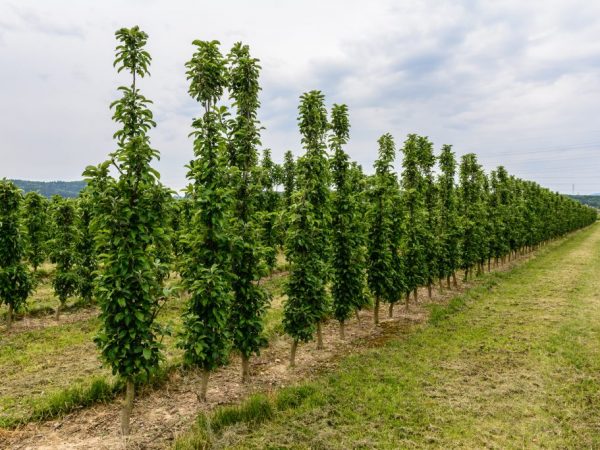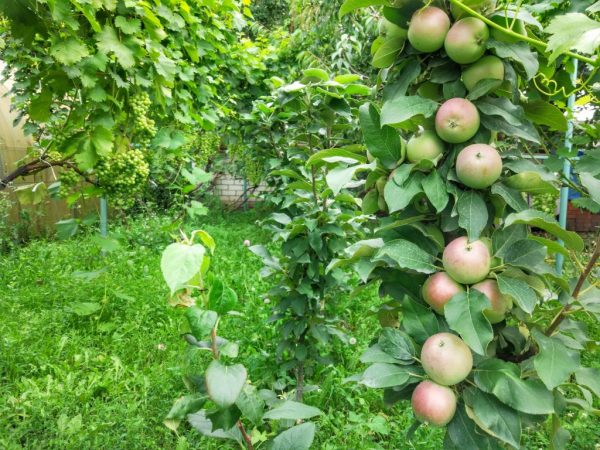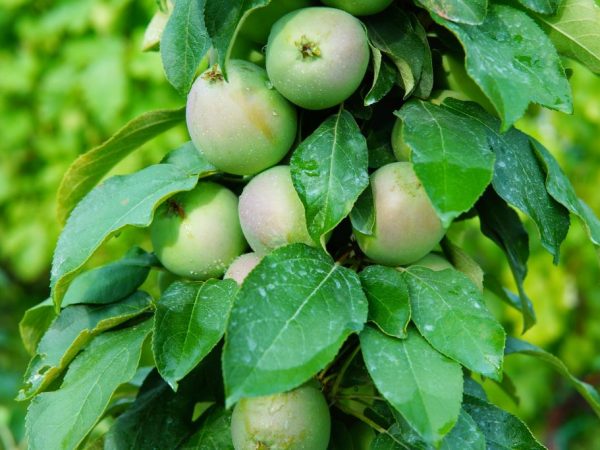Varieties of columnar apple trees for the Moscow region
Due to its compact shape, good yield and variety of varieties, the columnar apple tree has gained great popularity among gardeners in our country. Several varieties can be planted on one site at once, each of them has its own ripening time. Consider which columnar apple trees are best suited for the Moscow region.

Varieties of columnar apple trees for the Moscow region
general description
Almost all varieties of this group are characterized by rapid growth, development and consistently high productivity.
Trees with a compact crown are fast-growing, with high adaptive abilities, therefore they grow well in areas of risky farming, have high resistance to various parasites and infections.
Unlike ordinary trees, the columnar apple tree does not tolerate wintering well. Life expectancy is no more than 15 years; even a rejuvenating haircut does not help the restoration of the apple tree.
After reviewing a brief description of zoned hybrids and varieties, you will be able to choose the most suitable crop for your garden.
Winter varieties
All winter columnar apple varieties for the Moscow region begin to give a late harvest - towards the end of autumn. In cool conditions, the fruit can be stored until spring.
Arbat
A large-fruited hybrid that gives its first fruits after 5 years of cultivation.
The apples are sweet, round-oval, rich cherry color with a glossy sheen. Full ripening occurs 25-30 days after removal. The picking is carried out in the last 10 days of August.
The advantages of the Arbat apple tree include:
- annual and high yield rates;
- frost resistance;
- increased resistance to infections;
- excellent taste and decorative qualities.
Currency
A fruitful frost-resistant hybrid, forms the first ovaries in the fourth year after planting.
The apples are round, green in color, contain an unusual barrel of red stripes. Stored for 3-4 months.
Moscow necklace
This hybrid is highly resistant to fungi and viruses - powdery mildew, scab. The apples are sweet, globular, deep crimson, green in the area of the stalk.
The taste and marketability of the variety are excellent. The mass of one fruit is about 250 g.
Bolero
Large green apples, densely cover the trunk of the tree. Fruit weight is about 200-220 g. The apple is dense, greenish in color, closer to the tip of a pale pink color.
The pulp is juicy, firm, sweet, slightly sour.
Amber necklace
The tree is compact, small in stature - up to 2 m in height. It is appreciated for its good productivity every year - 50-60 kg of fruit can be removed from one seven-year-old tree.
The apples are sweet, medium-sized, weighing about 150 g, green with a pale pink barrel.
The plant is endowed with good resistance to parasites and apple infections.
Autumn varieties

Autumn fruits can be kept fresh for up to three months
Autumn varieties include apple trees that ripen in the first or second month of autumn. The main quality is the long-term preservation of the fruits (up to 3 months in the basement).
Vasyugan
A tree of medium vigor with a columnar crown, practically does not form side shoots. Fruits with fruits of average weight - 150-200 g.
The apples are yellow, contain blurry pink stripes, elongated-conical. Apples are sweet and sour, juicy and aromatic.
Suitable for cultivation in the Moscow region and the Moscow region, because it has increased frost resistance.
Ostankino
The variety belongs to dessert crops with beautiful, flat apples reaching 160 g in weight. In terms of taste and marketability, it is one of the most valuable varieties with juicy, firm and aromatic pulp. The harvest is stored until January.
Gin
A productive hybrid, the number of fruits on the tree increases every year. Young trees 5-6 years old yield about 7 kg, adults - 20-25 kg of apples.
The apples are scarlet, spherical, average weight - up to 100 g, stored until the end of January.
Titania
The Moscow region and the Moscow region are excellent for the cultivation of this crop. Average weight - 100 g. Fruits are juicy with firm, sweet-sour pulp and scarlet coloring. The shape is round.
The harvest of this fruit crop has a pleasant wine aroma and is often used to make ciders and wines.
Summer varieties
In summer (early) apple trees, the fruiting period is long - it begins in July and ends in early September, but the keeping quality of the crop is no more than a month. Therefore, they are immediately allowed for processing or consumed fresh.
The best varieties of columnar apple trees for the Moscow region:
- The president. A short tree - 2 m in height. Gives tasty fruits with increased juiciness and sweetness. The average weight is 200 g. The fruit is light green, without blush, spherical.
- Nectar. The apples are yellow, hard, easily transported over long distances and have a good keeping quality - until May. They have a honey aroma and increased sweetness. The average weight is 250-270 g.
New hybrids
In addition to the old varieties described above, modern breeding offers gardeners of the Moscow region new hybrid forms adapted to the climate of this zone.
- Bratchud. Winter culture, reaching 2.7 m in height. The first fruits ripen in the fourth year. The apples are juicy, round or oval, light green in color. There is a seam on the surface. Weight varies from 150 to 250 g. The taste is sweet and sour.
- Candy. Begins to bear fruit in the fourth or fifth year, is distinguished by high yield rates - from 30 to 50 kg of apples from one tree. The fruit is bright yellow in color with a striped pink blush, weighs 90-120 g, sweet, juicy.
- Dialog. Early trees - ripen in late summer (mid or late August). The crop deteriorates quickly - after about a month, so it must be processed within a few weeks after being harvested. Fruits are bright yellow, juicy, flat-rounded, weight from 70 to 100 g. Taste - sweetish-sour. They are stored for no more than a month, so they must be immediately recycled.
- Grounded. Summer-autumn hybrid, bears fruit with large juicy and tasty fruits. The undersized crop has good yields (up to 130 kg from an apple tree 7-8 years old). Greenish-yellow apples with a bright scarlet barrel, weigh about 90-130 g. The flesh is crispy, sweet with a slight sourness.
- KV-17. This early ripe hybrid gives large fruits (weight about 200 g), scarlet or fiery color with excellent taste and aroma. Average yield - up to 15 kg from one apple tree.
Growing rules

Good care will ensure you have a good harvest
The successful cultivation of columnar varieties depends on many factors: the site, the composition of the soil, the scheme and timing of planting, as well as further care and preparation for winter. Observing all the subtleties of growing, your work will be justified.
Timing
You can plant a columnar apple tree both in spring and in the autumn. But in this zone, gardeners prefer spring planting, because the risk of freezing of young apple trees and their subsequent death after wintering is reduced.
But if you have acquired planting material in the fall, it must be planted no later than the first ten days of October, so that young trees have time to take root and adapt in a new place before the onset of cold weather.
The optimal time for planting is early spring, when the snow melts. The main thing is to have time to plant the plants before the process of sap flow begins.
Preparation of seedlings
In order for the plants to take root quickly and successfully, it is recommended to use strong one-year or two-year-old seedlings without signs of diseases, pests and mechanical damage.
Before deepening into the soil, they are dipped for 2 hours in a clay solution (3 liters of clay per 3 liters of water).
Pit preparation
Before planting seedlings, you need to prepare a hole - its depth and width should correspond to the length and diameter of the roots (approximately 80x60 cm).
The dug earth is mixed with a bucket of last year's manure or compost, 100 g of potassium nitrate and 100 g of superphosphate are added.
Half a bucket of drainage is poured into the bottom of the pit - crushed stone, pebbles, pieces of broken bricks are suitable. Then the hole is half filled with a nutrient mixture, covered with a thin layer of soil without any additives to prevent the roots from burning.
A peg is driven in to tie the trunk and further protect from the winds.
Landing technique and scheme
The roots of the plant are lowered into a hole, leveled, sprinkled with soil and trampled around the stem. When planting, it is important that the area of the root collar is just above the ground.
Apple trees are watered with water (2 buckets for each plant) and the trunk area is sprinkled with an earthen hill to eliminate the risk of drying out the soil and roots.
For group planting, two schemes are used:
- compacted - the distance between trees is 0.5 m, in a row 1-1.5 m;
- sparse - the distance between seedlings and rows is 1 m.
Care features
All subsequent care of young seedlings consists in regular watering and feeding.
- In the first 3 months, you should carefully monitor the condition of the soil around the seedlings - it should always be slightly moistened. Watering is carried out through grooves dug at a distance of 50 cm from the near-stem zone. 2-3 buckets of water are poured under one plant. Then they carry out the procedure of loosening the soil, removing weeds and mulching with garden soil. The frequency of watering depends on the condition of the soil and weather conditions - usually during the dry season, water at least 5 times.
- Columnar trees respond well to feeding with intensive growth, development and abundant yields. The first fertilizer is applied at the stage of blooming of vegetative buds. Use a composition of 1 st. l. azofoski or nitrophoska, 1 liter of mullein or bird droppings solution. The mixture is brought to a volume of 10 l with water. Pour 2 liters of nutrient liquid under each plant. After 15 days, the seedlings are re-fed with a solution of superphosphate and potassium salt - 1 tbsp. l. on a bucket of water.
- The main care consists in preventive treatments for infections and parasites. For diseases, fungicides are used - Bordeaux mixture or copper sulfate. Processing is carried out 3 weeks after planting the seedlings and in the fall closer to winter. From pests (aphids, moths, weevils and sawflies), the crown and soil around the near-trunk zone are sprayed with one of the insecticides - Aktellik, Konfidor, Calypso, Fufanon, Iskra or Sunmight.
- varieties do not need pruning or shaping, since they do not develop lateral branches. But in case of damage to the upper kidney on the central conductor, the growth of two or three apices is possible. Of these, you should choose the strongest one, and cut the rest.
- Normalization of flower buds and ovaries ensures full-fledged growth of a young plant and eliminates the risk of overloading a seedling that has not yet matured.In the first year of flowering, all the buds are removed, which only take away the strength and energy of the young tree. In the second year, only 5-6 fruit ovaries are left, and the rest are removed, in the third year - 15 apples. Starting from the fourth year of life, the apple tree is ready for full fruiting.
- In the first years of life, seedlings must be covered for winter, otherwise they will freeze and die. Before covering the apple tree, the trunk zone is mulched with a thick layer of earth (rotted manure or peat), then the trunk is wrapped with foil and covered with spruce branches or spunbond.
Summing up
Many gardeners are engaged in planting and growing columnar apple trees in the Moscow region and the Moscow region and get a good harvest every year. Such success is ensured by adherence to the timing and all planting rules, as well as good tree care. The above growing technique will help to successfully carry out this process on your site.

